Visitors frequently flock to the more well-known tourist destinations of Tokyo, Osaka, and Kyoto, yet the modern port city of Nagoya offers a unique draw of its own.
Echoes of vibrant ancient culture juxtapose with cutting-edge robotics and automobile manufacturing. Festivals celebrate the historic samurai legacy while innovative companies develop the futuristic technologies of tomorrow.
Walk in the footsteps of ancient samurai while the streets reverberate with the energy of industrialism and trade. The city is unfiltered, unedited, and authentic.
Welcome to this hidden gem located in the central region of Japan’s main island.
Welcome to Nagoya.
Jump Ahead:
- Planning a Trip to Nagoya
- How to Get to Nagoya
- Where to Stay
- Neighborhoods to Visit
- Safety Risks and Tips
- How to Deal with Medical Emergencies
- How to Get Around
- What to Eat
- What to Drink
- Things to See and Do
- Itinerary
- What to Do Before You Leave
Planning a Trip to Nagoya
When deciding what time of year to schedule your visit, keep these helpful tips in mind:
Weather
Nagoya’s weather is most temperate in late spring and late fall. These seasons are perfect for spectators visiting for a variety of international sporting events. The average high temperatures of 20-24 degrees Celsius (68-75 degrees Fahrenheit) in April, May, and October feel comfortable for outdoor sightseeing.
The summer months are hot, humid, and rainy. If you decide to visit in the summer, ensure your packing list includes an umbrella and lightweight, breathable clothes.
Dreaming of witnessing the Nagoya landscape dusted with snow? Bundle up and time your arrival for January or February.
Seasonal Events
Along with events to mark Japan’s national holidays, the city and its surrounding areas host other yearly events such as:
Hadaka Matsuri (Naked Festival)
Get your lunar new year off to a memorable start when you attend the naked festival. This two-day festival begins on the 13th day of the lunar year (around the end of February or beginning of March). Started in 767, the purpose of the festival is to ward off bad luck and illness in the upcoming year. Expect a lively atmosphere and thousands of nearly naked men parading the streets.
Directions:
Take the Meitetsu Line from Nagoya to Konomiya Station, then walk 3 minutes to the festival.
Hōnen Matsuri (Fertility Festival)
Each spring on March 15th, Nagoya holds a unique festival to celebrate fertility and bountiful harvest. Attend the 1,500-year-old festival and witness a parade unlike any other. You’ll see phallic symbols everywhere, and the star of the show is a 2.5-meter-long carved wooden phallus weighing 300 kg. Come hungry so you can partake in the themed food choices.
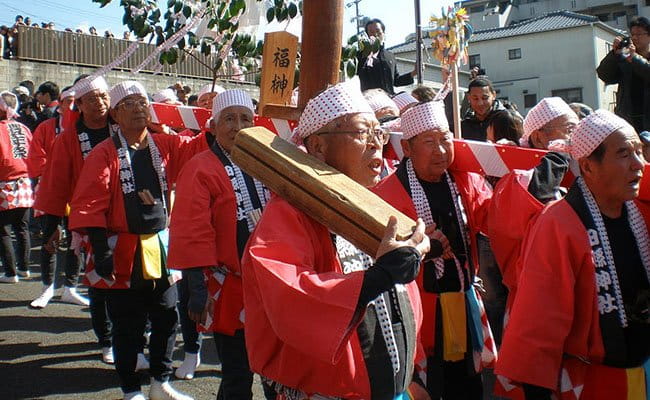
Photo by KKPCW Courtesy of Wikimedia
Directions:
Take the Meitetsu Line from Nagoya to Inuyama. Transfer to the Komaki Line and get off at the Tagata Jinja Mae stop. Walk about 10 minutes to the Ogata Shrine.
Hanami (Cherry Blossom) Viewing Parties
Set aside time to enjoy the beauty of the city’s cherry blossoms if you’re fortunate enough to visit while they’re in bloom (usually between late March and early April).
Relax with a picnic lunch in Higashiyama Park or enjoy a stroll along the Yamazaki River. Craving a romantic date night? Tsuruma Park illuminates its cherry blossoms until 9:00 p.m.
Directions:
To view the cherry tree-lined portion of the Yamazaki River, take the Sakuradori (red) Line to Mizuho-Kuyakusho Station and walk 10 minutes to the Kanae-Bashi Bridge.
See Higashiyama Park’s 3,800 cherry trees by taking the Higashiyama (yellow) Line to Higashiyama-Koen Station and walking 10 minutes from Exit 3.
View Tsuruma Park’s night blossoms by taking the Tsurumai (blue) Line or JR train to Tsurumai Station.
Atsuta Festival
The Atsuta Shrine hosts its annual festival on June 5th. Events are held throughout the day culminating with a firework display at 9:00 p.m. Arrive in the morning to witness the Emperor’s messenger being greeted by the shrine priests. Spend the afternoon watching tea ceremonies, noh theater, and kendo demonstrations.
As the sun sets, collect a snack from one of the many food stands and find a spot in nearby Shirotori Park to watch the fireworks.
Directions:
Take the Meijo (purple) Line to Jingu-Nishi Station and walk 7 minutes from Exit 2.
Minato Matsuri (Port Festival)
In Japan, the 3rd Monday in July is known as the Day of the Sea. Nagoyans host their Nagoya Port Festival on this national holiday. Festival events usually begin shortly after noon with a rafting contest and continue with dancing and music. Come hungry since there are plenty of street food delicacies to sample. The festival concludes with a nearly hour-long fireworks show at 7:30 p.m.
Directions:
Take the JR train from Nagoya Station to Kanayama Station. Transfer to the Meijo (purple) or Meiko (parallel purple) Line to Nagoyako Station.
Tenno Festival
Travel to the 500-year-old Tenno Festival and experience the beauty of a night time boat procession lit by hundreds of traditional paper lanterns. The two-day festival, held on the 4th Saturday and Sunday in July, also features flute music, taiko drumming, and a firework show.
Directions:
Take the Meitetsu Line to Tsuhima Station and walk 15 minutes to the Tsushima Shrine and Tenno River Park.
Nagoya Sumo Tournament
Join the cheering crowds at Nagoya’s yearly sumo tournament. The July event is one of only 6 major sumo tournaments held each year in Japan.
Directions:
Take the Meijo (purple) Line to Shiyakusho Station and walk 8 minutes to the Aichi Prefectural Gymnasium (Dolphin’s Arena).
World Cosplay Summit (WCS)
The Osu shopping area welcomes cosplayers year-round, but from late July to early August, the whole Sakae neighborhood is filled with colorful costumes and all your favorite manga and anime characters. Welcome to the World Cosplay Summit. Bring a camera to capture photos of cosplayers from over 35 countries as they parade the streets.
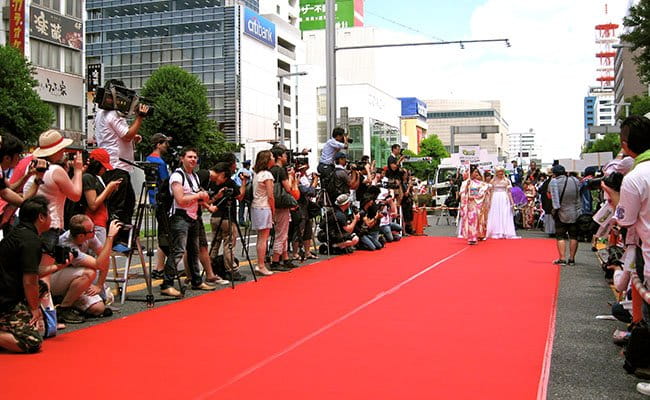
Photo 野田準也 by Courtesy of Wikimedia
Directions:
Take the Tsurumai (blue) Line to Ōsu Kannon Station.
Nagoya Castle Summer Festival
Starting the first Friday in August, Nagoya Castle brings history to life with its thirteen-night Summer Festival. When the hot summer day turns into a balmy evening, traditional paper lanterns are lit, the castle itself is illuminated, and the party begins. Enjoy a beer from the beer garden, watch bon dancing, listen to music, and eat your way through the food stands.
Directions:
Take the Tsurumai (blue) Line to Sengencho Station or the Meijo (purple) Line to Shiyakusho Station.
Nagoya Festival
Nagoya’s samurai history is on full display the first weekend of October as the city pays tribute to the three unifying heroes of the nation. Over 700 festival participants don period clothes and samurai armor for the procession down the streets of Nagoya.
Expect to see battle re-enactments celebrating Oda Nobunaga, Toyotomi Hideyoshi, and Tokugawa Hideyoshi throughout the two-day festival.
Directions:
From Nagoya Station, take the Higashiyama (yellow) Line to Sakae Station and transfer to the Meijo (purple) Line. Get off at Shiyakusho Station and walk 2 minutes to Nagoya City Hall where the parade begins.
Ōsu Street Performers Festival
In mid-October, Osu Street celebrates the creative arts in a 2-day festival with nearly 250 artists, musicians, and street performers showcasing their skills.
Walk the street and take in everything from juggling to dancing to magic tricks. If you are there at the right time, you just may catch a procession of women dressed as oiran (historical Japanese courtesans).
Directions:
Take the Tsurumai (blue) Line to Ōsu Kannon Station.
Prices
Airfare and hotel costs vary throughout the year. The winter season between December and February tends to be the least expensive due to the cold weather. Average low temperatures during this season range from 0-3 degrees Celsius (32-37 degrees Fahrenheit).
If the colder weather doesn’t bother you and you want to avoid the heat and rain of the summer season, time your Nagoya visit for winter. Your wallet will thank you.
Crowds
Despite being Japan’s fourth most populous city, Nagoya remains relatively unvisited by international tourists. This is good news for travelers craving a more authentic Japanese experience.
Want an even more private visit? Time your trip for winter – Nagoya’s coldest, but least busy season.
How to Get to Nagoya
Most visitors to Nagoya will fly into the closest airport and take ground transportation into the city.
The Port of Nagoya is primarily geared toward commercial traffic, so nearby private yacht slips are harder to find and not readily available. If you plan to visit Nagoya by private boat, Kisogawa Marina and Shinmaiko Boat Park are good starting points when searching for a slip.
Airports Near Nagoya
Nagoya’s closest airport is Chūbu Centrair International Airport (NGO) located 35 kilometers (22 miles) south of the city. Both domestic and international airlines service this airport.
International travelers should be aware that in some cases, direct flights to Centrair may be more expensive than making a connection. Nearly twenty domestic airports provide connecting service to Centrair, which can be helpful for budget-conscious travelers.
Transit Options from the Airport
From the airport, visitors can reach Nagoya by train, bus, taxi, private shuttle, or rental car.
Train
The Meitetsu Line train travels from the airport to Nagoya Station in 28 minutes. Upon arrival at Nagoya Station, you can connect with the bus or subway lines. A one-way adult ticket costs 1,230 yen.
Bus
The Centrair Limousine bus departs once every hour from 8:15 a.m.–10:15 p.m. This bus travels from the airport to Nagoya Station in 88 minutes, making stops at several major hotels along the way. A one-way adult ticket is 1,200 yen.
Travelers arriving on early-morning or late-night flights can catch the Airport Liner bus for a direct 55-minute connection between the airport and Nagoya Station. The late-night bus departs the airport at 12:40 a.m. and the early-morning service begins at 7 a.m. A one-way adult ticket is 1,500 yen.
Taxi
Four different companies offer taxi service between Centrair Airport and Nagoya. The average fare for the 50-minute drive to Nagoya Station is 16,000 yen. A noriai (rideshare) service is also available.
Private Shuttle
For groups, a private shuttle provides direct service from the airport to your destination. The shuttle accommodates up to seven people and reservations must be made at least one day in advance. The average cost for a trip to central Nagoya is 13,850 yen.
Rental Car
Five rental car companies are located at the airport. The average daily rental price is 9,800 yen.
Where to Stay in Nagoya
A visit to Japan provides the opportunity to experience several types of unique lodging in addition to standard hotels.
Ryokans (traditional Japanese inns) and minshukus (guest houses or bed and breakfasts) feature traditional futon beds and tatami mat rooms. Guests typically share toilets and bathrooms in these types of lodgings. Meals may be included or available for an additional charge.
Travel Tip: Japanese lodging prices are often per person, not per room. Avoid surprises by paying careful attention to how your rate is calculated.
Budget Lodging in Nagoya
Chisun Inn Nagoya
1-12-8 Noritake, Nakamura, Nagoya
+81 052-452-3211
The Chisun Inn offers basic, affordable accommodations within a 5-minute walk of Nagoya Station.
Rates: Starting from 4,700 yen per person for a standard single bedroom without breakfast, or 5,700 yen with breakfast
Amenities: Optional breakfast buffet, free Wi-Fi, parking (1,200 yen per day)
WASABI Nagoya Ekimae
13-5 Tsubakimachi, Nakamura, Nagoya
+81 052-451-8380
This capsule-type lodging offers a men’s dormitory and a women’s dormitory, each with a maximum occupancy of 28 persons. It features private rooms and the pleasant scent of tatami mats.
Travel Tip: Capsule hotels have similar expectations to private Japanese homes. They may request that you remove your shoes and place them in a storage locker when you enter the hotel.
Rates: 2,500 yen per person for a capsule bed in the same-sex or co-ed dormitory, or 2,000 yen for a bunk bed in the co-ed dormitory
Amenities: Free Wi-Fi and use of a computer, a TV, air conditioning, reading lamp, electric outlets, communal toilets and bathrooms on each floor, no meal options
What Should I Expect from a Capsule Hotel?
Capsule hotels aren’t for everyone, but they offer an inexpensive place to sleep for adventurous travelers on a budget.
The capsule hotel concept originated in Osaka in 1979. Capsule or pod hotels have many extremely small modular “rooms” or bunks with an average size of 2 x 1.25 x 2 meters (6.6 x 4.1 x 3.2 feet).
Original capsule hotels were intended to accommodate businessmen who had missed the final train home. Many capsule hotels today are still male only. Others, like the WASABI Nagoya Ekimae, are open to both men and women.
Wondering what to expect from a capsule hotel? Plan to sleep in a private, thinly-walled capsule within a large dormitory-style room. You will have access to shared bathroom and shower facilities as well as a locker where you can store your belongings. Amenities vary by hotel and may include toiletries, use of a robe and slippers, in-capsule TV, and access to a public bath.
Miyuki Ryokan
47-2 Kouun, Kita, Nagoya
+81 052-875-5525
Enjoy one of the most affordable ryokan experiences in Nagoya. Your traditional tatami mat sleeping room can hold futon beds for you and 2-4 friends or family members.
Rates: 7,500 yen per room for a 3-person room, or 12,000 yen per night for a 5-person room
Amenities: Free Wi-Fi, refrigerator, microwave, communal toilets and bathrooms, no meal options
Mid-Range Lodging in Nagoya
Show Wa no Yado Tsuchiya
1-16-2 Michishita, Nakamura, Nagoya
+81 052-451-0028
Groups or families of up to five people can share a semi-western style room at this minshuku. Your room has its own bathroom and toilet, futon mats for sleeping, and a traditional Japanese dining area.
Rates: Starting from 6,431 yen per person. For stays of at least three consecutive nights, the starting rate drops to 5,145 yen per person.
Amenities: Free Wi-Fi, private toilet and bathroom, free parking for one car, no meal options
Samurai House
2-39 Nakajima, Nakamura, Nagoya
+81 50-3634-9344
Built in 2017, Samurai House is one of the newest and most upscale minshukus in Nagoya. A fusion of Japanese and western cultures provides guests with the best of both worlds.
The private two-story house can accommodate up to eight guests. It has four single and two double traditional Japanese futon beds, a bathroom, dining area, family room, kitchenette, and a washer/dryer.
Rates: Starting from 6,351 yen per person
Amenities: Free Wi-Fi, private toilet and bathroom, kitchenette, washer and dryer, free parking, and complimentary use of four bicycles
Watanabe
2-1-14 Chikusa, Chikusa, Nagoya
+81 052-731-2501
Watanabe is a traditional ryokan known for its delicious food, beautiful garden, and soothing hot springs baths. Each guest room contains two futons and a low table seating area.
Rates: Starting from 7,034 yen per person without breakfast, or 7,584 yen with breakfast
Amenities: Free Wi-Fi, free parking, communal toilets and bathrooms, massage services, and dinner reservations available
Luxury Lodging in Nagoya
Kyoya Ryokan
2-11-4 Habashita, Nishi, Nagoya
+81 052-571-2588
Unwind in a luxurious sanctuary of Zen relaxation near Nagoya Castle. The two-story ryokan encircles a peaceful garden and traditional Japanese bath house.
Several types of rooms are available, the most stunning of which are the second-floor garden-view rooms, melding modern amenities with traditional Japanese styling.
Soak up the culture of sleeping on a traditional futon and wearing a yukata (Japanese bathrobe) while retaining the modern amenities of a private bathroom, shower, dining area, and living room.
Rates: Starting from 22,680 yen per person for single occupancy second-floor garden-view rooms. Note that rooms can accommodate 1-4 guests and the price per person decreases with each additional guest. The per person rate for four guests starts from 8,316 yen.
Amenities: Free Wi-Fi, private toilet and bathroom, complimentary use of bicycles, meal reservations available: 1,998 yen for a traditional Japanese style breakfast and 5,940 yen for dinner
Travel Tip: All guests at Kyoya Ryokan must be over the age of 12.
Nagoya Katei Miyoshi
2-16-3 Noritake, Nakamura, Nagoya
+81 052-452-3418
Relax your body and indulge your taste buds at an elegant ryokan known for its culinary masterpieces.
Sleep peacefully on a traditional futon in your tatami mat bedroom then wake to enjoy breakfast while seated on a cushion at a low table. After your meal, head up to the rooftop or garden to soak in one of the two traditional baths.
Rooms of all sizes, with and without private toilets and bathrooms, are available. This ryokan can accommodate everyone from single travelers to groups of twenty-four.
For the most privacy, enjoy a deluxe Japanese-style, non-smoking room with private toilet and bathroom.
Rates: Starting from 8,634 yen per person for the deluxe room without breakfast. With breakfast included, the starting rate is 9,726 yen per person. The rate for the room with both breakfast and dinner included starts from 14,788 yen per person.
Amenities: Free shuttle bus, free parking, massage services available
Nagoya Prince Hotel Sky Tower
4-60-12 Hiraike, Nakamura, Nagoya
+81 052-565-1110
Sleep amongst the stars and overlook the city from a luxurious deluxe corner room at the Nagoya Prince Hotel Sky Tower.
Guests staying in a deluxe corner room are welcome to enjoy additional accommodation privileges including a breakfast buffet, tea time, sweets time, a cocktail reception, and alcoholic beverages. Sample a full range of Nagoya’s culinary delights from the plush comfort of your hotel.
Rates: Starting from 31,500 yen per person for a deluxe corner room, or 12,355 yen per person for a king sky room
Amenities: Free Wi-Fi, refrigerator, fitness center, business center, on-site restaurant, parking (2,000 yen per night)
Lodging Near Toyota Stadium
If you are traveling to Nagoya for a sporting event, you may want to stay in Toyota to be close to the stadium.
The three closest hotels are:
AB Hotel Toyota Motomachi
3-63-1 Toshin, Toyota
+81 0565-31-8005
Rates: Starting from 2,977 yen per person for a single room with breakfast included
Amenities: Pubic bath, business center, massage service available
Toyota Prestige Hotel
4-28 Kitamachi, Toyota
+81 0565-34-5555
Rates: Starting from 7,100 yen per person for a single room
Amenities: Free Wi-Fi, refrigerator, parking, three on-site restaurants, breakfast available for 900 yen, dinner available by advance request
Hotel Toyota Castle
COMO Square West, 2-160 Kitamachi, Toyota
+81 0565-31-2211
Rates: Starting from 14,850 yen per person for a single room
Amenities: Free Wi-Fi, free parking, four on-site restaurants, breakfast buffet available for 1,620 yen
Neighborhoods in Nagoya
Here’s an overview of the key neighborhoods you should be sure to visit as you explore Nagoya:
Sakae
Sakae is at the heart of downtown Nagoya. Signature landmarks include the Nagoya TV Tower and Oasis 21 building. Visit Sakae during the day for both department store and luxury brand shopping. You will know you have arrived when you start seeing groups of young, very expensively dressed “Nagoya Girls.”
Return at night for the entertainment, dining and nightlife. Enjoy a theatrical or musical event at the Aichi Arts Center or hit a high energy dance party at one of many local nightclubs. The 5-story iD Café is particularly popular.
Sakae is located on the Meijo (purple) subway line and Meitetsu Seto train line. The Me~guru sightseeing bus also makes a stop at the Nagoya TV Tower during the day.
Meieki
Meieki is located near the hub of downtown Nagoya and is named after its most prominent building – the Nagoya Station complex. Visit Meieki to enjoy a view of the swirling Mode Gakuen Spiral Tower buildings. Pay a visit to the luxury shops of Midland Square or the underground mall and savor gourmet food from one of the hundreds of restaurants.
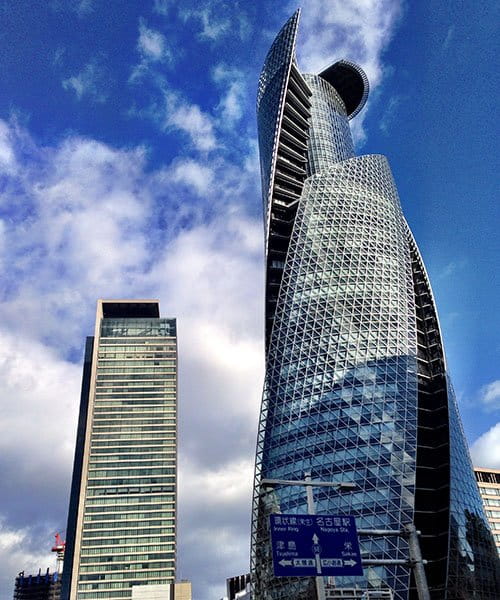
Nagoya Station can easily be reached by subway, bus and train.
Fushimi
Fushimi is a commercial area of Nagoya. Expect to see businessmen and banks on your walk to the Nagoya City Science Museum or Nagoya City Art Museum. The nightlife here is a little more subdued than in nearby Sakae. Visitors can unwind at British and Irish pubs as well as an American sports bar.
Reach Fushimi by taking either the Tsurumai (blue) or Higashiyama (yellow) subway line.
Port of Nagoya
The Garden Pier area around the Port of Nagoya showcases the vibrance and modern infrastructure that is developing in Nagoya. Arrive plenty early so you have time to enjoy the aquarium, maritime museum, and Legoland Japan.
Take the Meiko (two parallel purple lines) subway line to the Port of Nagoya.
Toyota
Toyota is a neighboring city east of Nagoya. It is home to Toyota Motor Corporation, which offers local plant and museum tours.
Sports fans can take the train from Nagoya to Toyota to watch sporting events at Toyota Stadium.
Safety in Nagoya
Before you start exploring, here’s what you should know about the safety status of the local area:
Crime Risk
Overall, the Nagoya area is very safe and has a low risk of violent crime. The more crowded entertainment neighborhoods of Sakae and Naka pose a moderate risk for non-violent crimes.
The most common concerns here are thefts of wallets/purses, cash, and credit cards, as well as the skimming of credit card numbers.
Safety Tips
Lower your risk by keeping credit cards in an RFID blocking wallet in your front pocket or in a concealed money belt. If you must carry a purse, consider a sturdy crossbody style rather than a more easily stolen backpack or shoulder bag.
It’s also wise to use an ATM located inside of a bank branch or hotel lobby if you need to withdraw cash. These are generally safer to use than those located along the street. Avoid ATM machines that show possible signs of tampering and guard your PIN number as you enter it.
Travel Tip: Dial 110 if you have an emergency and need to contact the police.
Medical Emergencies in Nagoya
Preparation is the best way to combat medical emergencies during a trip abroad. Be sure to take note of the local medical facilities and purchase travel medical insurance before you depart.
Medical Facilities
There are several multilingual hospitals in the Nagoya and Toyota areas:
- Holy Spirit Hospital
56 Kawanayama, Showa, Nagoya
052-832-1181
- Nagoya Daini Red Cross Hospital
2-9 Taemi, Showa, Nagoya
052-832-1121
- Toyota Kosei Hospital (this hospital provides 24-hour emergency services)
500-1 Ibobara, Jusui, Toyota
0565(43)5000
Travel Tip: Dial 119 if you experience a medical emergency while in Nagoya.
Travel Medical Insurance
Does your domestic health insurance cover you abroad? Japan offers world-class medical care to locals and foreign visitors alike, but this care can come at a price.
That’s why investing in travel medical insurance prior to your trip is an important part of the preparation process. Some travel health plans start at just a dollar a day. Many will allow you to choose the deductible, overall coverage maximum, and length of coverage that’s right for you.
Unfortunately, accidents and injuries can happen anywhere at any time, and the potential costs and stress of traveling without insurance are too high to ignore.
Not sure where to start? Visit our Travel Health Insurance for Japan page to learn whether you need insurance for your trip, what to look for in a plan, and how to buy.
How to Get Around in Nagoya
Japan is in the process of updating its signage to include multiple languages. Most of Nagoya’s public transit systems already have signs and kiosks in multiple languages. Many attractions also have both Japanese and English signage. Still, be prepared to find some locations with only Japanese signs.
Travel Tip: Bring a guidebook. If you will be traveling with a global smart phone, also download travel apps in your native language.
Public Transit
Nagoya’s local public transit system is well-developed and consists of both bus routes and subway lines.
You can purchase tickets at subway stations, on board city buses, at city bus offices, and at transportation bureau service centers.
In addition to one-way fares, there are unlimited-ride one-day passes available:
- Donichi Eco Kippu – This pass allows one day of travel on Me~guru, Nagoya’s sightseeing bus, for just 600 yen (300 yen for children under age 12). It also provides discounts to many attractions around Nagoya, including the Nagoya City Museum, Nagoya City Art Museum, Nagoya Castle, and more. It is available for use only on Saturdays, Sundays, national holidays, and the 8th day of each month.
- Me~guru One-Day Pass – This pass offers one day of unlimited rides on Me~guru, Nagoya’s sightseeing bus, for just 740 yen (370 yen for children under age 12). It is available for use every day.
- Shoryudo Nagoya Subway and Bus One-Day Ticket – Available to foreign visitors, this ticket provides unlimited rides on Nagoya city buses, subways, and Me~guru for just 600 yen. There is no separate price for children. The ticket is available for use every day.
- Bus/Subway Combination Ticket – This ticket permits one day of unlimited rides on both buses and the subway for just 850 yen (430 yen for children under age 12). It is available for use every day.
- Bus-Only Ticket – This ticket permits one day of unlimited bus rides for just 600 yen (300 yen for children under age 12). It is available for use every day.
- Subway-Only Ticket – This ticket permits one day of unlimited subway rides for just 740 yen (370 yen for children under age 12). It is available for use every day.
Planning to stay longer than one day? Nagoya does not currently have discounted multi-day public transit tickets, but you may be interested in a Manaca card. A Manaca card is a travel card that you can pre-load with funds and then use to travel on buses, the subway, and the Aonami train line. Certain stores and vending machines also accept Manaca cards as a method of payment.
Save some money by using your Manaca card if you will be making a transfer or connection within the public transit system in a 90-minute period. Qualifying transfers and connections receive a fare discount of 80 yen.
Familiarizing yourself with a new city’s public transit system can be intimidating, but the Nagoya’s Transportation Bureau’s tourist guide can answer just about every question you have.
City Bus
Travel throughout Nagoya on one of the city bus lines. Tickets for general/key route buses cost 210 yen each way. Add an additional 10 yen if your bus route takes you on one of the expressways.
Staying out late? The special late-night bus service runs nightly from Monday to Friday at one-way adult fares of 420 yen. Pay half price if you have a one-day ride ticket.
From 9:00 a.m. to 8:00 p.m., visitors can easily travel between many of the city’s key sites on the C-758 line. It is tourist-friendly with free Wi-Fi and on-board LCD panels that display upcoming stops in English, Korean, Chinese, simplified Chinese and Japanese.
An adult one-day unlimited ride bus ticket costs 600 yen.
Subway
Nagoya’s subway system has color-coded lines and readily available system maps. The six lines travel through five zones to cover the entire city. Many of Nagoya’s top attractions are located within walking distance of the subway.
One-way adult tickets cost 200-330 yen depending on how many zones you travel through.
An adult one-day unlimited ride subway ticket is 740 yen.
Sightseeing Bus
Want to easily travel from one sightseeing destination to the next? The Me~guru, Nagoya’s official sightseeing bus, is specifically designed for tourists. It travels in a loop from Nagoya Station to ten popular sightseeing destinations and runs every day except Mondays and during the New Year’s holidays.
Tickets are sold as a single ride or one-day pass with unlimited rides. Adult prices are 210 yen for single rides or 500 yen for unlimited. The pass also provides discounted admission to many tourist attractions.
Train
If Nagoya is your base of travel to other cities, Nagoya Station – the largest train station in the world in terms of floor area – will connect you with trains that run throughout the country.
Vehicle Rentals
The average price for a rental car is 9,800 yen per day. International visitors need to plan ahead and obtain an International Driving Permit (IDP) prior to getting behind the wheel. It can take minutes to weeks for your permit to be processed depending on the issuing administration process in your country. The permit is good for up to a year from the issue date. Always carry your valid IDP and your driver’s license from your home country while driving in Japan.
Bicycle
The wide streets of Nagoya are well-suited for bicycling. Bicycles are available for rent at rates of around 1,500 yen per day for a city bike. Check with your hotel first as some hotels provide complimentary bicycles.
What to Eat in Nagoya
When the City of Nagoya conducted a domestic tourism survey, they found–unsurprisingly–that over half of their fellow Japanese tourists were there to see the Nagoya Castle. What was draw number two? The local cuisine.
Ask a Nagoyan what foods their city is known for and you will be urged to sample:
Kishimen
Kishimen is a dish of flat udon noodles and sliced leeks bathed in a soy sauce soup. It is served either hot or cold. Stand and eat your kishimen with the locals at one of Kishimen Sumiyoshi’s Nagoya Station train platform locations. An order of kishimen is just 350 yen.
- Kishimen Sumiyoshi
Inside JR Nagoya Station, 1-1-4 Mei, Nakamura, Nagoya
In the mood for a more relaxed and scenic dining experience? Enjoy a bowl of kishimen while overlooking the Minamishinike pond at the Atsuta Shrine.
- Miya Kishimen – Jingu
Atsuta Jingu Shrine, 1-1-1 Jingu, Atsuta, Nagoya
+81 052-682-6340
Red Miso Katsu
Red miso katsu is a delightfully crispy pork cutlet paired with local sweet red miso sauce. Try this dish at is Misokatsu Yabaton, an eatery that specializes in red miso katsu.
Prices range from 432 yen to 1,836 yen depending on the size and variety of katsu dish you choose.
3-6-18 Osu, Naka, Nagoya
+81 052-252-8810
Tebasaki
Tebasaki is a variety of chicken wings with a unique flavor profile. Nagoya restaurants marinate their wings in a sweet sauce then coat them with sesame seeds and a secret blend of spices.
When choosing the best place to sample tebasaki, it only makes sense to go right to the source–the restaurant that started Nagoya’s wing revolution: Sekai no Yamachan. A serving of five wings is 450 yen, and the restaurant’s website kindly provides a tutorial on the art of eating chicken wings in case you are a little rusty.
4-9-6 Sakae, Nakamura, Japan
+81 052-242-1342
Hitsumabushi
Hitsumabushi is a rice and grilled eel dish served in a wood bowl. For the full experience, divide your hitsumabushi into four sections and eat them one at a time.
The flavors of the eel takes center stage while eating the first section. When you are ready for your second portion, top the eel and rice with condiments. The standard third portion consists of rice, eel, and condiments with the addition of green tea or broth to form a soup. The final portion is your choice– add whatever topping you most enjoyed.
Get your hitsumabushi at Atsuta Houraiken where they have been cooking this classic dish since 1873. A standard serving of hitsumabushi costs 3,900 yen. For the extra hungry tourist or for sharing with a friend, a full order plus an additional half order option is available for 5,500 yen.
503 Godo, Atsuta, Nagoya
+81 052-671-8686
Uiro
For dessert, indulge in uiro, a local version of Japan’s mochi dessert. Traditional Nagoyan uiro is flavored with matcha, red bean paste, chestnut paste, or yuzu (a local citrus fruit).
End a day of shopping with a trip to Toraya Uiro for freshly made uiro. Sample until you find your favorite flavor. Prices average 500 yen per dessert.
Matsuzakaya Nagoya Main Building B1F, 3-16-1 Sakae, Naka, Nagoya
+81 052-264-3864
Travel Tip: Carry cash as some restaurants do not accept cards.
Travel Tip: Unlike many western countries, Japan does not have a custom of tipping. Here, the act of tipping may be considered disrespectful. Show your appreciation of outstanding service through words, not money.
What to Drink in Nagoya
Beer
Y Market Brewing Kitchen is Nagoya’s premier craft brew pub. This colorful bar makes its own beers in an on-site brewing room and the best brews have made appearances at pubs and festivals in Tokyo. If you get the chance, try the Meyon Lager or the Hop Seduction IPA.
The “kitchen” portion of Y Market’s name comes from the cook-your-own-barbecue restaurant located on the pub’s third floor. Reservations are required, and Y Market is cash only, so stop at the ATM before arriving.
4-17-6 Meieki, Nakamura, Nagoya
+81 052-533-5151
Fruit Drinks
Skillfully mix ripe fruit, fresh herbs, craft alcohol, and mason jars and what do you get? A beautifully photogenic, uniquely delicious, and refreshing drink experience from Kitsune Tempura Stand.
Tantalize your taste buds with a pineapple + lemongrass blend or perhaps a kiwi + mint combo. Kitsune also serves up a broad selection of plum wines and other cocktails. Pair your drink with some delicious fresh tempura or a unique appetizer.
5-2-1 Imaike, Chikusa, Nagoya
+81 052-734-7525
Things to See and Do in Nagoya
Museums
Highlights: Rare treasures and art from the Edo period
Address: 1017 Tokugawa, Higashi, Nagoya
Hours: 10 a.m.– 5 p.m. (last admission at 4:30 p.m.), closed Mondays
Admission (adult): 1,400 yen
Public Transit Access: 3-minute walk from Tokugawaen Shindeki bus stop, 10-minute walk from Ozone train station
Highlights: Largest planetarium in the world
Address: 2-17-1 Sakae, Naka, Nagoya
Hours: 9:30 a.m.– 5 p.m. (last admission at 4:30 p.m.), closed Mondays
Admission (adult): 800 yen for museum + planetarium, 400 yen for museum only
Public Transit Access: 5-minute walk from Fushimi Station and Hirokoji-Fushimi bus stop
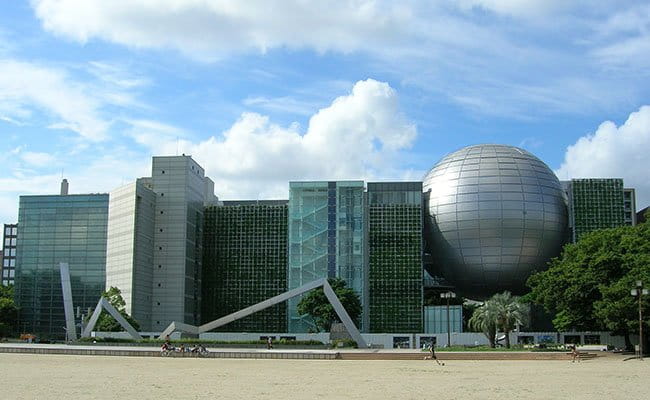
Photo by KAMUI Courtesy of Wikimedia
Highlights: Collection of 39 retired train cars, train simulators, dioramas
Address: 3-2-2 Kinjofuto, Minato, Nagoya
Hours: 10 a.m. – 5:30 p.m. (last admission at 5 p.m.), closed Tuesdays
Admission (adult): 1,000 yen
Public Transit Access: Kinjo-futo Station on the Aonami Line
Highlights: 160 vehicles showcasing Toyota’s history
Address: 41-100 Yokomichi, Nagakute
Hours: 9:30 a.m.– 5 p.m. (last admission at 4:30 p.m.), closed Mondays
Admission (adult): 1,000 yen
Public Transit Access: Higashiyama (yellow) Line from Nagoya to Fujigaoka, transfer to Meitetsu Bus to Toyota Automobile Museum, 5-minute walk from bus stop
Highlights: Eco cars, GAZOO Racing cars, winglet ride experience (Tuesday-Friday from 1:45 p.m. – 3:20 p.m.)
Address: 1 Toyota, Toyota
Hours: 9:30 a.m.– 5 p.m., Closed Sundays
Admission (adult): Free
Public Transit Access: Higashiyama (yellow) Line from Nagoya to Fushimi Station, take the Tsurumai (blue) Line to the Meitetsu Toyota Line. At Toyotashi Station, transfer to the Meitetsu Bus which travels directly to Toyota Kaikan Museum.
Historical Buildings
Highlights: The first castle to be designated a National Treasure of Japan, Noh Theater
Address: 1-1 Honmaru, Naka, Nagoya
Hours: 9 a.m.–4:30 p.m. (last admission at 4 p.m.), free guided tour at 1 p.m. daily
Admission (adult): 500 yen
Public Transit Access: Tsurumai (blue) Line to Sengencho Station, or Meijo (purple) Line to Shiyakusho Station, Me~guru Bus
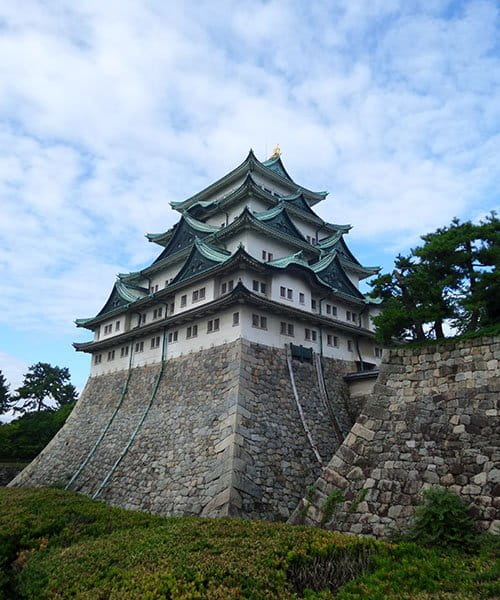
Temples and Shrines
Highlights: Japan’s second most important Shinto shrine, home of the Kusanagi-no-Tsurugi (an ancient sword considered one of the Three Sacred Treasures of Japan).
Address: 1-1-1 Jingu, Atsuta, Nagoya
Hours: 24 hours
Admission (adult): Free
Public Transit Access: Jingu-Nishi subway stop
Highlights: Buddhist Shingon temple originally built around 1333, red paper wishing lantern, collection of 15,000 books, flea market on the 18th and 28th of each month
Address: 21-47 Osu 2, Naka, Nagoya
Hours: 24 hours
Admission (adult): Free
Public Transit Access: Ōsu Kannon Station on the Tsurumai (blue) Line
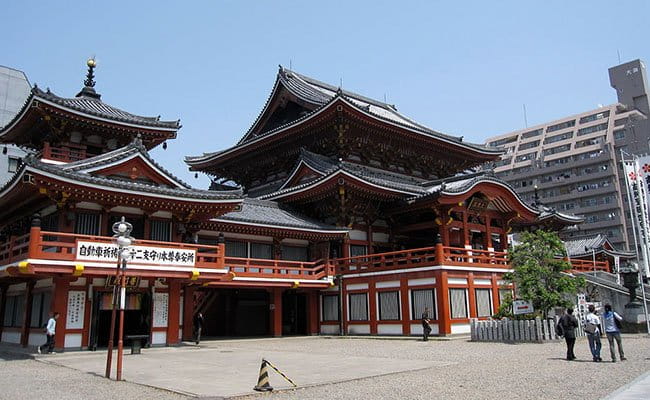
Photo by Gryffindor Courtesy of Wikimedia
Parks, Gardens, Hot Springs, and Scenic Views
Highlights: Oldest park in Nagoya, European and Japanese landscaping, sculptures
Address: 1 Tsurumai, Showa, Nagoya
Hours: 8:30 a.m.–9:30 p.m. daily
Admission (adult): Free
Public Transit Access: Tsurumai Station on the Tsurumai (blue) Line
Highlights: River, waterfall, pond, and rock formations
Address: 1001 Tokugawa, Higashi, Nagoya
Hours: 9:30 a.m.–5:30 p.m. (last admission at 5 p.m.), closed Mondays
Admission (adult): 300 yen for garden, 1,500 yen for art museum
Public Transit Access: 15-minute walk from Ozone Station
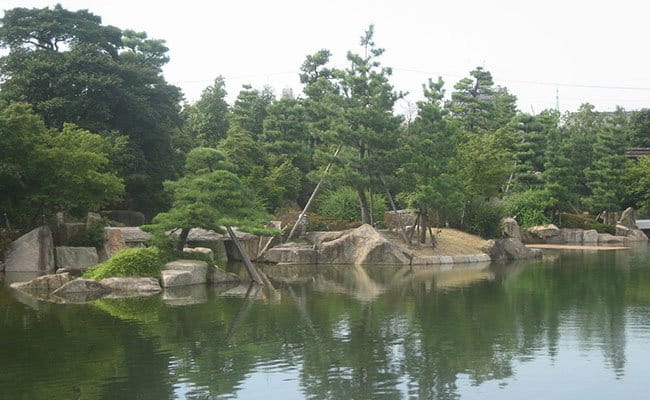
Photo by Ben W. Courtesy of Wikimedia
Highlights: The Shikinomichi (Path of Four Seasons)–a kilometer-long portion of the river lined in cherry trees–listed as one of Japan’s 100 best cherry blossom viewing locations.
Public Transit Access: Mizuho Undojo Higashi Station
Highlights: Historic villa and gardens
Address: 2-5-17 Hoo, Chikusa, Nagoya
Hours: 9:30 a.m.–4:30 p.m., closed Mondays
Admission (adult): North Garden: Free, Choshokaku: 300 yen
Public Transit Access: 10-minute walk from Kakuozan Station on the Higashiyama (yellow) Line
Highlights: Sky Promenade–open air observation platform atop 5th tallest building in Japan, Higashiyama (Sky Restaurant)–food and drinks with a stunning panoramic city view
Address: 4-7- Meieki, Nakamura, Nagoya
Hours: Sky Promenade: hours vary by season; shops: 11 a.m.–8 p.m., Restaurants: 11 a.m.–11 p.m.
Admission (adult): 750 yen for Sky Promenade single access, or 1,050 yen for all-day pass
Public Transit Access: Nagoya Station (5-minute walk)
Highlights: Naturally rejuvenating radon hot springs for bathing and drinking, massages and food available
Address: 21 Kano, Umamichi, Toyota
Hours: Day-use bathing from 9:30 a.m.–11:30 p.m. Monday–Friday and 8 a.m.–11:30 p.m. on weekends and holidays (last admission at 11 p.m.)
Admission (adult): 1500 yen
Public Transit Access: Not directly accessible by public transit
Travel Tip: Be prepared – public baths are enjoyed in the nude. Remember to shower and cover any tattoos prior to entering the bath.
Shopping
Highlights: Eclectic collection of shops including many that cater to cosplayers
Public Transit Access: Ōsu Kannon Station on the Tsurumai (blue) Line
Highlights: Photogenic architectural landmark with boutique shops and restaurants
Address: 1-11-1 Higashi, Higashi, Nagoya
Hours: 10 a.m.–9 p.m. daily
Public Transit Access: Sakae stop on the Higashiyama (yellow) Line
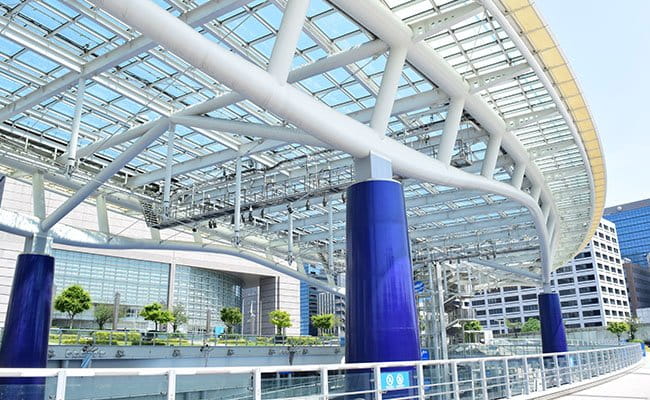
Highlights: Underground mall with over 80 shops offering a combination of apparel, souvenirs, and local foods
Address: 6-9 Tsubaki, Nakamura, Nagoya
Hours: 10 a.m.– 8:30 p.m.
Public Transit Access: Nagoya Station
Tours
Highlights: craft center (view production of bone china), museum, china painting experience (separate hours and fees)
Address: 3-1-36 Noritake-Shimmachi, Nishi, Nagoya
Hours: 10 a.m.– 5 p.m.
Admission (adult): 500 yen (for craft center and museum), no admission charge for gardens
Public Transit Access: Nagoya Station
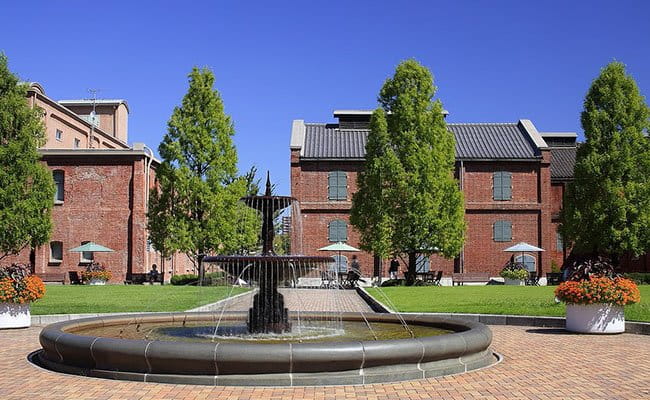
Photo by Tomio344456 Courtesy of Wikimedia
Highlights: View vehicles on assembly line
Address: Tours depart from the Toyota Kaikan Museum: 1 Toyota, Toyota
Hours: Meet at 10:30 a.m. and return at 1 p.m., Monday–Friday
Admission (adult): Free, make reservation online at least three days in advance
Public Transit Access: From Nagoya, take the Tsurumai (blue) Line to Meitetsu Toyota Line. At Toyotashi Station, transfer to the Meitetsu Bus to the Toyota Kaikan Museum.
Attractions
Higashiyama Zoo and Botanical Gardens
Highlights: Japan’s largest Asian elephant house, Higashiyama Sky Tower, amusement park, oldest greenhouse in Japan
Address: 3-70 Higashiyama Motomachi, Chikusa, Nagoya
Hours: 9 a.m.–4:50 p.m. (last admission at 4:30 p.m.), closed Mondays
Admission (adult): 500 yen
Public Transit Access: Hoshigaoka Station
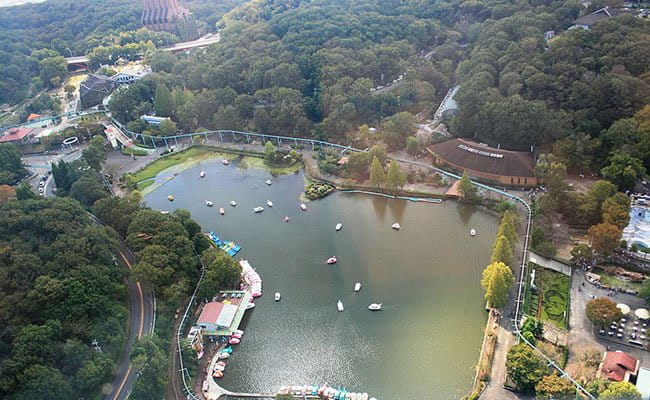
Photo by Alpsdake Courtesy of Wikimedia
Port of Nagoya Public Aquarium
Highlights: Dolphin performance, orca training, penguin encounter, jellyfish, sea turtles
Address: 1-3 Minato-Machi, Minato, Nagoya
Hours: 9:30 a.m.–5:30 p.m. (last admission at 4:30 p.m.), closed Mondays
Admission (adult): 2,500 yen
Public Transit Access: Nagoya-ko Station on the Meiko (parallel purple) Line
Highlights: Miniland (mini versions of ten Japanese locations), over 40 rides, brick factory (see LEGO bricks being made)
Address: 2-2-1 Kinjo Futo, Minato, Nagoya
Hours: Usually 10 a.m.– 5 p.m. daily; check calendar for current hours
Admission (adult): 4,500 to 6,900 yen. Save money by purchasing off-peak tickets seven days in advance.
Public Transit Access: Kinjo-futo Station on the Aonami Line
Sporting Venues
Highlights: Rugby matches, B1 Sports plaza (indoor swimming pool)
Address: 7-2 Sengoku, Toyota
Hours: varies by event
Admission (adult): varies by event
Public Transit Access: The Tsurumai (blue) Line, travels from central Nagoya to Akaike. Stay on the train as it switches to the Meitetsu Line which takes you to Toyotashi Station. Toyota Stadium is located 1.75 km (1 mile) from Toyotashi Station.
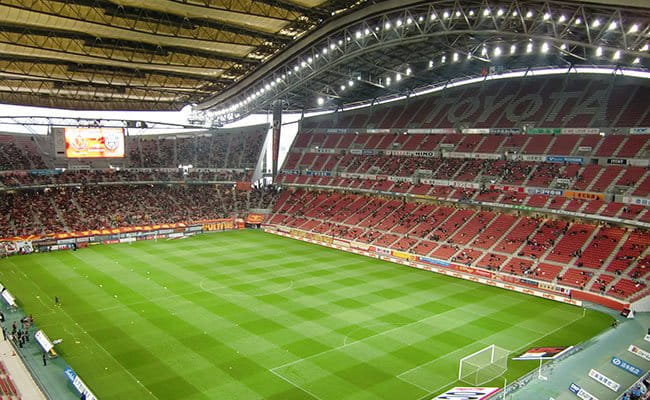
Photo by WAKA77 Courtesy of Wikimedia
Unique Nagoya Itinerary
In a city known for its manufacturing, you can manufacture something of your own–a unique experience taking you far beyond the confines of the standard tourist guidebook destinations.
For the Outside-the-Box Traveler
Nagoya offers a line-up of memorable and sometimes quirky activities. Perhaps the most unique of these offerings is a food sample-making experience.
Have you ever wondered where and how those artificial food samples in restaurant windows are made? This is your opportunity to not only tour the factory, but to also have the fun of crafting your very own souvenir sample.
For the Foodie
Hungry for some real food coupled with a hands-on experience? Foodies can spend their morning on a private tour of the Yanagibashi Fish Market followed by a sushi-making class. The next day, treat yourself to an afternoon making delicious soba noodles.
For the Creative Traveler
Imagine returning home having had a wonderful time and learning a fun, new skill. Your friends will be impressed with your newfound origami, furoshiki, and shodo techniques.
Let your inner artist out to play with a shibori tie dye or manga drawing workshop.
For the Cultural Traveler
Mingle with Nagoya’s locals and experience their city the local way by booking a slot on a three-hour cultural immersion tour. Your local guide will introduce you to Nagoya’s neighborhoods, nightlife, food, and drinks.
Finally, embark on the Kiyosu samurai walking tour and Kiran Brewery visit for some light exercise, a mini history lesson, and the chance to savor three local beers.
What to Do Before Your Trip
You’ve completed your research, finalized your plans, and we know you can’t wait to set out on your grand Nagoyan adventure.
Before you catch your flight, double check that you remembered to:
- Confirm your passport is current, valid, and will not expire within the next six months
- Obtain a Japan travel visa if it is required for citizens of your country
- Secure travel medical insurance and pack your ID card and a copy of your policy
- Obtain an International Driving Permit if you plan to drive while in Japan
- Make reservations for lodging, transportation, tours, events, etc.
Nagoya awaits.
Explore More Japan City Guides from WorldTrips
- – Fukuoka City Guide
- – Osaka City Guide
- – Sapporo City Guide
- – Tokyo City Guide
- – Yokohama City Guide
Explore More Japan Travel Content from WorldTrips
KHE2FFFYH6SP-152-1463
WorldTrips international travel medical insurance products are underwritten by Lloyd's. WorldTrips is a service company and a member of the Tokio Marine HCC group of companies. WorldTrips has authority to enter into contracts of insurance on behalf of the Lloyd's underwriting members of Lloyd's Syndicate 4141, which is managed by HCC Underwriting Agency, Ltd.
